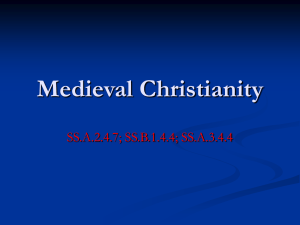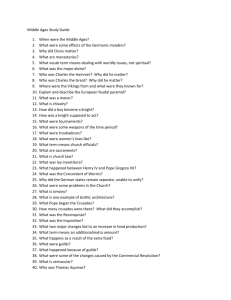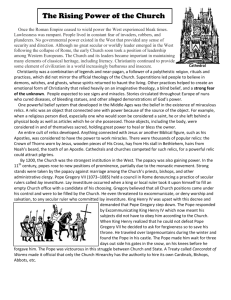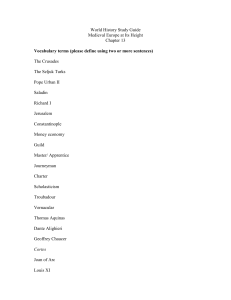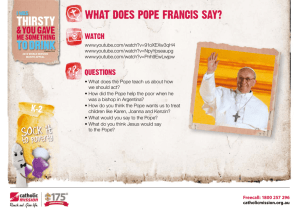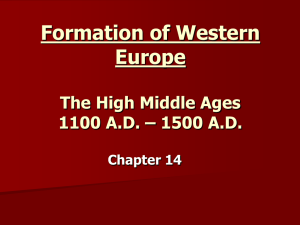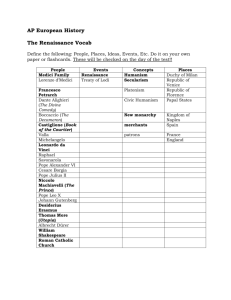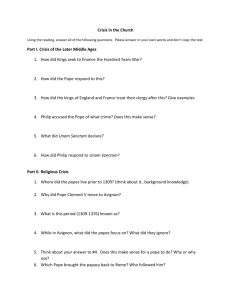Medieval Christianity - Mater Academy Lakes High School
advertisement
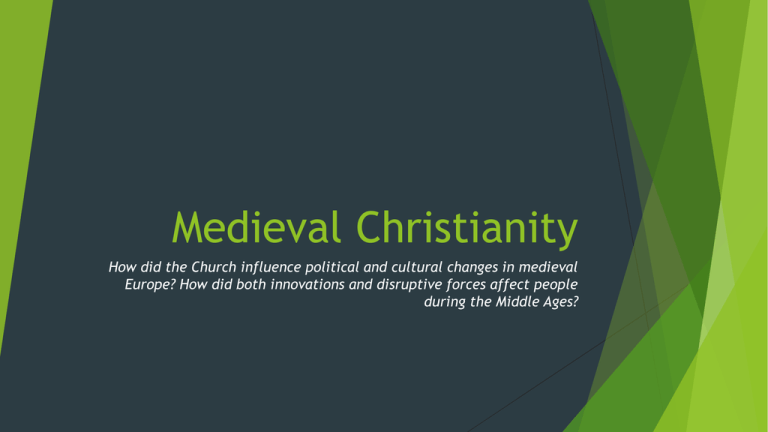
Medieval Christianity How did the Church influence political and cultural changes in medieval Europe? How did both innovations and disruptive forces affect people during the Middle Ages? The Papal Monarchy Guiding Question: How did the political power of the Catholic Church change between the papacies of Pope Gregory VII and Pope Innocent III? Since the fifth century, the popes of the Catholic Church had claimed supremacy over the affairs of the Church. • had also gained control of territories in central Italy that came to be known as the Papal States. • This control kept the popes involved in political matters, often at the expense of their spiritual duties. (meaning they put politics before their religious duties.) • The Church became involved in the feudal system. Reform of the Papacy • By the eleventh century, Church leaders realized the need for a separation of Church and State. • When an individual became a Church official in the Middle Ages, he was given a ring and a staff. ---These objects symbolized the spiritual authority with which the Church granted, or invested, the official. -Secular, or lay, rulers usually chose nominees to Church offices and gave them the symbols of their office, a practice known as lay investiture. -Pope Gregory VII decided to fight this practice. Lay investiture - the practice by which secular rulers both chose nominees to church offices and gave them the symbols of their office Elected pope in 1073, Gregory was convinced that he had been chosen by God to reform the Church. • claimed that he—the pope—was truly God's "vicar on earth" and that the pope's authority extended over all the Christian world, including its rulers. • believed that only by eliminating lay investiture could the Church regain its freedom. • Then the Church would be able to appoint clergy and run its own affairs. • If rulers did not accept this, the pope would remove them. Gregory VII soon found himself in conflict with Henry IV, Holy Roman Emperor and king of Germany, over these claims. • For m any years these claims conflicted between the popes and kings. • Kings had no intention of obeying the pope. Struggle between the pope and king. The struggle between Henry IV and Gregory VII, known as the Investiture Controversy, was one of the great conflicts between church and state in the High Middle Ages. • dragged on until a new German king and a new pope reached a compromise known as the Concordat of Worms in 1122. • Under this agreement, a bishop in Germany was first elected by Church officials. • After election, the new bishop paid homage to the king as his lord. • The king in turn invested him with the symbols of temporal (earthly) office. • A representative of the pope, however, then invested the new bishop with the symbols of his spiritual office. New Religious Order - Cistercians founded in 1098 by a group of monks who were unhappy with the lack of discipline at their own Benedictine monastery. • Cistercian monasticism spread rapidly from southern France into the rest of Europe. • were strict. • ate a simple diet, and each had only a single robe. • All decorations were eliminated from their churches and monastic buildings. • More time for prayer and manual labor was gained by spending fewer hours at religious services. The Cistercians played a major role in developing a new, activistic spiritual model for twelfth-century Europe. • Benedictine monks spent hours inside the monastery in personal prayer, but the Cistercians took their religion to the people outside the monastery. Women in Religious Orders The number of women joining religious houses also grew dramatically. • most nuns were from the ranks of the landed aristocracy. • Convents were convenient for families who were unable or unwilling to find husbands for their daughters, for aristocratic women who did not choose to marry, or for widows. Female intellectuals found convents a haven for their activities. • Many educated women would flock to convents. Ideal for practicing. Franciscans and Dominicans In the 1200s, two new religious orders emerged that had a strong impact on the lives of ordinary people. They were the Franciscans and the Dominicans. • The Franciscans were founded by Francis of Assisi. • Francis was born to a wealthy Italian merchant family in Assisi. • After having been imprisoned during a local war, he had a series of dramatic spiritual experiences. • These experiences led him to abandon all worldly goods and to live and preach in poverty, working and begging for his food. • His simplicity, joyful nature, and love for others soon attracted a band of followers, all of whom took vows of absolute poverty, agreeing to reject all property and live by working and begging for their food. • The Franciscans became very popular. They lived among the people, preaching repentance and aiding the poor. Their calls for a return to the simplicity and poverty of the early Church, reinforced by example, were especially effective. The Franciscans also undertook missionary work, first throughout Italy and then to all parts of Europe and the Muslim world. The Dominican order was founded by a Spanish priest, Dominic de Guzmán. • Dominic wanted to defend Church teachings from heresy—the denial of basic Church doctrines. • The spiritual revival of the High Middle Ages led to the emergence of heresies within the Church. • Adherents of these movements were called heretics • Heretical movements became especially widespread in southern France. • Dominic believed that a new religious order of men who lived in poverty and could preach effectively would best be able to attack heresy. The Inquisition Religion in the High Middle Ages • Emphasis on the role of the saints was closely tied to the use of relics, usually bones of saints or objects connected with saints. • Relics were considered worthy of worship because they were believed to provide a link between the earthly world and God. • It was deemed that relics could heal people or produce other miracles. The Crusades Guiding Question - What were the religious, political, and economic motivations behind the Crusades? The Early Crusades Crusades - military expeditions carried out by European Christians in the Middle Ages to regain the Holy Land from the Muslims (Remember – At the end of the Byzantine Empire – Muslims were moving into that territory.) Crusades Aftermath

